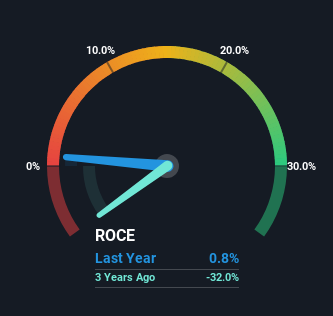VTEX (NYSE:VTEX) May Have Issues Allocating Its Capital
VTEX VTEX | 5.97 | +1.36% |
Finding a business that has the potential to grow substantially is not easy, but it is possible if we look at a few key financial metrics. Firstly, we'd want to identify a growing return on capital employed (ROCE) and then alongside that, an ever-increasing base of capital employed. Put simply, these types of businesses are compounding machines, meaning they are continually reinvesting their earnings at ever-higher rates of return. In light of that, when we looked at VTEX (NYSE:VTEX) and its ROCE trend, we weren't exactly thrilled.
Understanding Return On Capital Employed (ROCE)
For those who don't know, ROCE is a measure of a company's yearly pre-tax profit (its return), relative to the capital employed in the business. To calculate this metric for VTEX, this is the formula:
Return on Capital Employed = Earnings Before Interest and Tax (EBIT) ÷ (Total Assets - Current Liabilities)
0.0084 = US$2.3m ÷ (US$355m - US$77m) (Based on the trailing twelve months to June 2024).
Thus, VTEX has an ROCE of 0.8%. Ultimately, that's a low return and it under-performs the Interactive Media and Services industry average of 6.6%.

In the above chart we have measured VTEX's prior ROCE against its prior performance, but the future is arguably more important. If you'd like, you can check out the forecasts from the analysts covering VTEX for free.
The Trend Of ROCE
In terms of VTEX's historical ROCE movements, the trend isn't fantastic. To be more specific, ROCE has fallen from 2.9% over the last four years. However, given capital employed and revenue have both increased it appears that the business is currently pursuing growth, at the consequence of short term returns. And if the increased capital generates additional returns, the business, and thus shareholders, will benefit in the long run.
On a side note, VTEX has done well to pay down its current liabilities to 22% of total assets. So we could link some of this to the decrease in ROCE. What's more, this can reduce some aspects of risk to the business because now the company's suppliers or short-term creditors are funding less of its operations. Since the business is basically funding more of its operations with it's own money, you could argue this has made the business less efficient at generating ROCE.
The Bottom Line
In summary, despite lower returns in the short term, we're encouraged to see that VTEX is reinvesting for growth and has higher sales as a result. These growth trends haven't led to growth returns though, since the stock has fallen 59% over the last three years. As a result, we'd recommend researching this stock further to uncover what other fundamentals of the business can show us.
Like most companies, VTEX does come with some risks, and we've found 1 warning sign that you should be aware of.
This article by Simply Wall St is general in nature. We provide commentary based on historical data and analyst forecasts only using an unbiased methodology and our articles are not intended to be financial advice. It does not constitute a recommendation to buy or sell any stock, and does not take account of your objectives, or your financial situation. We aim to bring you long-term focused analysis driven by fundamental data. Note that our analysis may not factor in the latest price-sensitive company announcements or qualitative material. Simply Wall St has no position in any stocks mentioned.




